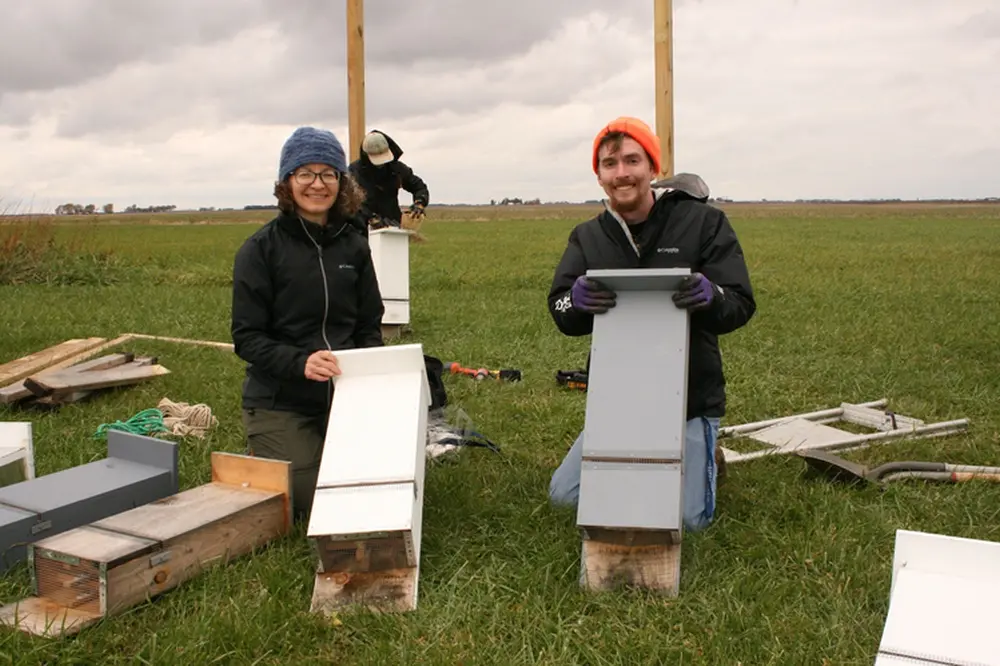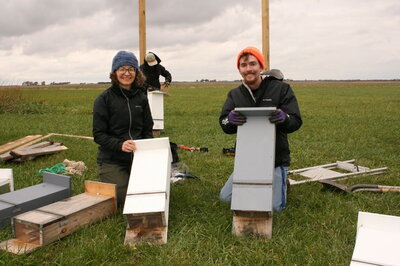

URBANA, Ill. — Artificial roosts for bats come in many forms — bat boxes, condos, bark mimics, clay roosts, and cinder block structures, to name a few — but a new conservation practice and policy article from researchers at the University of Illinois Urbana-Champaign suggests the structures haven’t been studied rigorously enough and may harm bats in some scenarios. The article, published in Conservation Biology, lays out potential dangers and encourages more research on the popular conservation practice.
“The major emphasis among conservation managers using artificial roosts is how to attract bats, typically by modifying design or landscape placement,” said Reed Crawford, doctoral student in the Program in Ecology, Evolution, and Conservation Biology at Illinois and lead author on the article. “Their measure of success is roost occupancy or bat abundance in roosts, but we really have no idea whether artificial roosts positively or negatively affect bats compared with natural roosts. What we do know is there are multiple significant perils associated with these artificial structures that need additional research.”
The dangers associated with artificial roosts mean they could act as ecological traps in some cases, according to Crawford and co-author Joy O’Keefe, assistant professor and wildlife Extension specialist in the Department of Natural Resources and Environmental Sciences and Illinois Extension, both part of the College of Agricultural, Consumer and Environmental Sciences (ACES) at Illinois.
“An ecological trap occurs when animal populations preferentially select sub-optimal habitat when higher-quality alternatives are available,” Crawford explained. “Basically, bats could inadvertently lower their chances of survival and reduce their reproductive success by choosing poorly designed or placed bat boxes.”
The best-documented concern is overheating. People installing artificial roosts often follow scientifically unsubstantiated advice to choose dark-colored structures and place them in sunny locations. The small structures rarely offer any insulation and can quickly reach temperatures beyond what bats can withstand. Unfortunately, there are all too many reports of mass bat deaths, with tiny bodies piled beneath roosts on the hottest days.
Crawford, O’Keefe, and others have documented thermal gradients inside bat boxes of various shapes, sizes, colors, and materials. Most designs reach dangerous temperatures, at least for short periods. But artificial roosts can also be too cold for healthy pup development. The authors share multiple reports of freezing deaths in bats during cold snaps in Florida and elsewhere. To improve outcomes for bats, the authors suggest assessing the conditions inside new designs before offering them to bats, aiming to strike a balance between reducing overheating risk and offering bats a microclimate suitable for raising their young.
Another concern is that artificial roosts could provide easier access by predators, such as snakes or raccoons, with little room for bats to retreat or escape.
When bats roost in trees, they tend to use multiple openings, be higher off the ground, and split up into smaller groups, which might disperse guano and make it harder for predators to see them or to sniff them out. According to O’Keefe, “We need to look at predation rates in natural and artificial roosts and develop effective guards and designs that keep roosting bats safe from predators.”
In their article, the researchers highlight ectoparasite accumulation as another understudied threat associated with artificial roosts.
“We found more than a thousand bat bugs inside some of the bat boxes we had installed for a previous study. We don't know if that’s normal or if it’s just something that's happening in these artificial roosts,” Crawford said. “It could be a really big deal when you potentially have 10 bat bugs for every one bat. To a bat, those would be like a golfball-sized parasite. They could lose a lot of blood. And we know the bugs preferentially target young bats and pups that can't groom themselves as effectively.”
The researchers note bat boxes may lure bats into low-quality habitat. Urban homeowners or farmers wanting bats for mosquito or crop pest control may inadvertently reduce bats’ diet choices to just a few insect species while likely increasing their exposure to environmental pollutants and novel predators, like prowling cats. Or a well-intended land owner might put up a bat box across a busy road from a forest, increasing the odds of vehicle collisions as bats head for the trees each night.
“There’s a lot more we need to know about bat health in urban and human-altered landscapes to inform decisions about where to place artificial roosts,” Crawford said.
Despite their potential pitfalls, many artificial roosts are “successful” in attracting large colonies of bats, sometimes hundreds of individuals. But Crawford and O’Keefe say those numbers could exacerbate the dangers of artificial roosts.
“Again, that's deemed a measure of success: if you see 500 bats in one box, that's fantastic. But there's a rare tree that could support that many individuals. In my experience tracking tree-dwelling bats, a colony is often spread across multiple tree roosts in a forest,” O’Keefe said. “And so, in bat boxes, you have this concentration of bats that's potentially more vulnerable — because there's so many of them — to predators, weather extremes, and ectoparasites. Having so many bats together could compound the risks to the population.”
Given that forest habitat is shrinking and bats most definitely need help, what’s a conservation manager or a homeowner to do?
“First, we need much more research on the effects of all of these factors on bats in artificial roosts. But I’d also encourage folks to look more holistically at their landscape and provide additional resources for bats,” Crawford said. “For example, adding clean water sources or maybe putting in pollinator gardens to attract different types of insects for greater dietary diversity. Looking at the artificial roost itself, make sure it’s high enough off the ground and not so small as to heighten exposure to overheating or predators.”
O’Keefe added, “I encourage people to look beyond their own backyards and think about whether there's a better place to install a roost nearby, like a park, that also offers foraging habitat for bats. Think at the neighborhood or village scale, as bats cover a lot of ground across their roosting and foraging areas. And no one should be putting up artificial roosts and walking away. You should be paying attention to them, keeping an eye on the bats and what's going on in and around the structure, including predators and ectoparasites, to know how bats using that structure might be affected.”
O’Keefe’s laboratory maintains a website with tips for making bat boxes safer for bats.
The article, “Improving the science and practice of using artificial roosts for bats,” is published in Conservation Biology [DOI: 10.1111/cobi.14170].